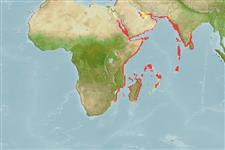Preferred temperature (Ref.
123201): 25.4 - 29.2, mean 27.5 °C (based on 406 cells).
Phylogenetic diversity index (Ref.
82804): PD
50 = 0.5000 [Uniqueness, from 0.5 = low to 2.0 = high].
Bayesian length-weight: a=0.01349 (0.00840 - 0.02167), b=3.02 (2.89 - 3.15), in cm total length, based on LWR estimates for this species & Genus-body shape (Ref.
93245).
Nível Trófico (Ref.
69278): 3.8 ±0.33 se; based on food items.
Resiliência (Ref.
120179): Médio, tempo mínimo de duplicação da população 1,4 - 4,4 anos (K=0.10-0.30; tm=3; tmax=27; Fec=26,700).
Prior r = 0.50, 95% CL = 0.33 - 0.75, Based on 3 data-limited stock assessments.
Fishing Vulnerability (Ref.
59153): High vulnerability (65 of 100).
🛈
Climate Vulnerability (Ref.
125649): High to very high vulnerability (73 of 100).
🛈
Nutrients (Ref.
124155): Calcium = 30.7 [21.0, 41.6] mg/100g; Iron = 0.709 [0.463, 0.998] mg/100g; Protein = 19.8 [17.3, 22.0] %; Omega3 = 0.118 [0.084, 0.162] g/100g; Selenium = 50.7 [25.2, 78.7] μg/100g; VitaminA = 33 [7, 181] μg/100g; Zinc = 2.28 [1.74, 2.84] mg/100g (wet weight); based on
nutrient studies. 